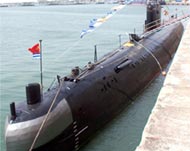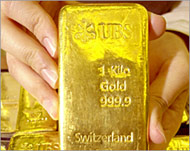Salvage expert sets eyes on Japanese warship
A Japanese submarine that may have been carrying a peace proposal to the Allies more than a year before the end of the second world war, is to be raised from the bottom of the Atlantic by an American salvage expert.

Ironically, the I-25 was sunk in June 1944 by Avenger torpedo bombers from the USS Bogue as it headed for the French port of Lorient.
As well as two tonnes of gold, underwater explorer Paul Tidwell believes diplomatic pouches aboard the vessel will reveal an offer from Tokyo that might have ended the war earlier and saved hundreds of thousands of lives.
“Messages like that could not go by radio because they were so secret,” Tidwell said.
The decorated veteran of the Vietnam War currently based in New Orleans, added: “The US State Department has told me that it wants to see the diplomatic pouches because it’s possible they contain the peace offer.”
The documents aboard the I-52 – which is three miles below the surface – were to be handed to Yoshiro Fujimura, Japan’s assistant naval attache in Germany.
Permission granted
A patriot who feared the devastation that could befall his homeland unless the war was stopped, Fujimura was in negotiations with Allen Dulles, the father of the CIA, in Switzerland in an effort to halt the conflict.
Tidwell, who believes the extreme depth and the lack of light or flora or fauna to consume the documents, will allow him to recover them, said: “The Japanese emperor thanked Fujimura for his efforts in a letter.
 |
|
Paul Tidwell has sunk $6 million |
“And maybe there are other things in there, like Japanese and German work on atomic weapons.”
Tidwell was only granted permission by the government in Tokyo to raise the submarine – the pride of the Imperial Japanese fleet – on 14 April, fully 10 years after first suggesting the project.
“Everyone is really happy with the outcome because it’s more valuable than just the money that is involved,” Tidwell said.
He located the I-52 in 1995, more than 1000 miles from the nearest land. “If we can recover it, we will make history. There is no other Japanese submarine on display anywhere in the world.
“I also hope that returning the vessel to Kure, its home port, might bring a sense of closure to those families who lost a relative when the I-52 was sunk,” he added.
Underwater masterpiece
When she was launched in December 1943, the I-52 was the largest submarine to ever put to sea. With a displacement of 3000 tonnes and 108 metres long, she was a masterpiece of underwater technology designed specifically to make the long journey between imperial Japan and Nazi Germany because surface vessels were too vulnerable to the Allies’ air and naval superiority.
Commanded by Kameo Uno, the I-52 left Japan on its maiden operational voyage in March 1944 with a crew of 94 and 14 passengers.
 |
|
Submarines are not as vulnerable |
After docking in Singapore, it had a cargo of nearly three tonnes of opium, for medical use, as well as rubber, tin, tungsten – and 146 bars of gold bullion.
Unfortunately for its crew, decoded radio messages to arrange a rendezvous with a German U-boat in the Atlantic enabled a US Navy battle group headed by the aircraft carrier USS Bouge to determine its location and get Avenger torpedo bombers airborne.
As the I-52 began to prepare for its approach to the French port of Lorient on 23 June 1944, it was spotted by an Avenger piloted by Lt Cmdr Jesse Taylor, who dropped depth charges and an acoustic torpedo.
Monitored aboard the aircraft, Taylor heard the torpedo detonate and metal grinding on metal as the I-52 fell 17,000 feet to the seabed.
Declassified documents
Tidwell said: “My journey started in 1990 when I began researching newly declassified documents from the National Security Agency in Washington.
“I was the first person to see the declassified documents on the I-52 and it was quickly clear that it was important in some way.”
 |
|
The vessel was carrying 146 bars |
In 1995, he chartered a former Sovet spy ship and scoured 1000 square miles of the Atlantic until the scanner located the I-52. With an estimated $30 million in gold within his reach, Tidwell’s attitude suddenly altered.
“There was a lot of money at stake, but actually locating the submarine changed things for me,” he said. “It was not just about the salvage operation anymore; I felt it was my responsibility to protect the vessel.”
He travelled to Japan and contacted as many surviving relatives of the crew as possible, who gave their personal blessing to his project.
He also opened negotiations with Japanese government officials, who were concerned about human remains that might still be aboard.
Human remains
Video footage taken from two small submarines sent down in 1998 to explore the wreck showed some of the crews’ personal effects, including shoes and clothing, while Tidwell also believes they have identified one set of human remains that can be seen through a hole in the pressure hull.
 |
|
The submarine was supposed to |
The vessel is instantly recognisable, with the sides of the conning tower still bearing large images of the rising sun and the anti-aircraft guns aiming skyward.
Damage is more serious in the bow area, where the torpedo
may have struck and then bore the brunt of the impact with the seabed.
“We are going to try to lift the submarine and bring it back to Japan,” he said.
“Technically, 17,000 feet – which is a mile deeper than the Titanic – is a challenge, but the technology is there and we want to embrace relationships with Japanese companies to achieve this.
Tidwell added: “I would like nothing more than to see the I-52, which was built by Mitsubishi, return home aboard a Mitsubishi ship.”
Permanent display
After it is lifted to the surface, the submarine will need to undergo treatment in the US to protect it from the elements before it goes on permanent display in its homeland.
|
“I hope that returning the vessel to Kure, its home port, might bring a sense of closure to those families who lost a relative when the Paul Tidwell |
Any human remains still within the vessel will be retrieved, along with the gold and diplomatic pouches.
Tidwell has already sunk $6 million of his own money into the project and expects another $10 million to be required to raise the I-52.
The Japanese government has agreed to reimburse his costs and provide 10% of the value of the gold.
Work to raise the I-52 could start as early as November, Tidwell said, with the operation likely to take about 30 days.